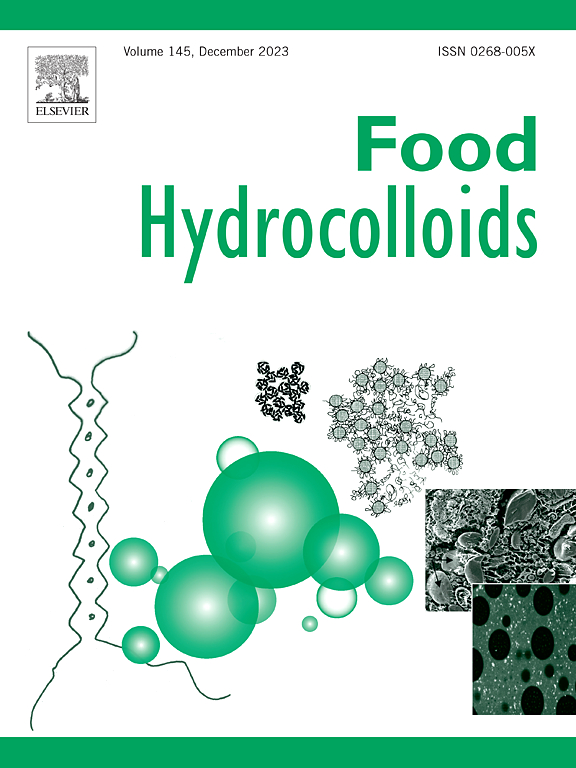基于玉米成分的胃稳定乳剂的构建:界面流变特性对叶黄素动态生物可及性的影响
IF 11
1区 农林科学
Q1 CHEMISTRY, APPLIED
引用次数: 0
摘要
乳剂负责化合物的递送,它们在人体消化道中的稳定性影响功能成分的吸收和利用。然而,乳剂在消化道中的稳定性,包括极端pH值、消化酶、剧烈的胃肠道蠕动等,却很少受到重视。在这项研究中,基于玉米衍生成分(即玉米谷蛋白水解物[GH],辛烯基琥珀酸酐改性玉米淀粉[OSAS]和玉米油)配制了胃稳定乳状液。GH/OSAS稳定乳状液的稳定性随GH水解度(DH)的变化而变化,DH先升高后降低,在GH/OSAS配合物浓度为2%时稳定性最佳。2% GH/OSAS络合物稳定的乳状液在体外消化过程中表现出良好的稳定性。在到达小肠前保持小液滴大小,获得了负载叶黄素的最高动态生物可及性。对界面性能的研究,包括界面张力和膨胀模量,解释了这一现象背后的机制。本研究为乳剂的营养功能提供了更深入的认识和方法,为开发改善人类健康的功能食品提供了新的方向。本文章由计算机程序翻译,如有差异,请以英文原文为准。

Construction of gastric-stable emulsions based on corn components: Impact of interfacial rheological properties on the dynamic bioaccessibility of lutein
Emulsions are responsible for the delivery of compounds, and their stability in the human digestive tract affects the absorption and utilization of functional components. However, there is little attention to the stability of the emulsions in the digestive tract, including extreme pH, digestive enzymes, violent gastrointestinal peristalsis, etc. In this study, gastric-stable emulsions based on corn-derived components (i.e., corn glutelin hydrolysates [GH], octenyl succinate anhydride modified corn starch [OSAS], and corn oil) were formulated. The stability of the emulsions stabilized by GH/OSAS varied with the hydrolysis degree (DH) of GH, which increased first and then decreased, reaching the best stability at the 2% GH/OSAS complex. The emulsion stabilized by 2% GH/OSAS complex showed excellent stability during the in vitro digestion process. It kept small droplet sizes until it reached the small intestine and obtained the highest dynamic bioaccessibility of loaded lutein. Investigation of interfacial properties, including interfacial tension and dilational modulus, explained the mechanism behind this phenomenon. This study provides deeper insights and methods for the nutritional functionality of emulsions, offering new directions for the development of functional foods that can improve human health.
求助全文
通过发布文献求助,成功后即可免费获取论文全文。
去求助
来源期刊

Food Hydrocolloids
工程技术-食品科技
CiteScore
19.90
自引率
14.00%
发文量
871
审稿时长
37 days
期刊介绍:
Food Hydrocolloids publishes original and innovative research focused on the characterization, functional properties, and applications of hydrocolloid materials used in food products. These hydrocolloids, defined as polysaccharides and proteins of commercial importance, are added to control aspects such as texture, stability, rheology, and sensory properties. The research's primary emphasis should be on the hydrocolloids themselves, with thorough descriptions of their source, nature, and physicochemical characteristics. Manuscripts are expected to clearly outline specific aims and objectives, include a fundamental discussion of research findings at the molecular level, and address the significance of the results. Studies on hydrocolloids in complex formulations should concentrate on their overall properties and mechanisms of action, while simple formulation development studies may not be considered for publication.
The main areas of interest are:
-Chemical and physicochemical characterisation
Thermal properties including glass transitions and conformational changes-
Rheological properties including viscosity, viscoelastic properties and gelation behaviour-
The influence on organoleptic properties-
Interfacial properties including stabilisation of dispersions, emulsions and foams-
Film forming properties with application to edible films and active packaging-
Encapsulation and controlled release of active compounds-
The influence on health including their role as dietary fibre-
Manipulation of hydrocolloid structure and functionality through chemical, biochemical and physical processes-
New hydrocolloids and hydrocolloid sources of commercial potential.
The Journal also publishes Review articles that provide an overview of the latest developments in topics of specific interest to researchers in this field of activity.
 求助内容:
求助内容: 应助结果提醒方式:
应助结果提醒方式:


